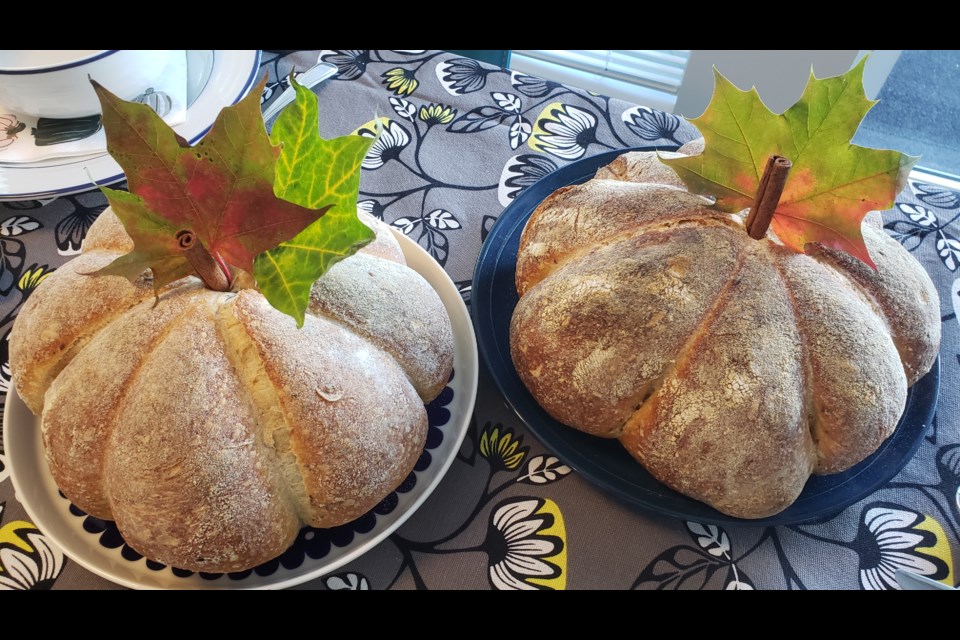During the pandemic, when people around the world emptied jars of flour to bake Instagram-worthy focaccias and banana bread, Ela Marlowe, a New West resident, joined a Finnish sourdough baking group on Facebook.
Unlike many who had never kneaded dough before the lockdown, Marlowe knew a thing or two about baking.
She had grown up watching her dad bake sourdough rye bread back in Finland.
“I even remember when he started the rye bread starter. It was 50 years ago. I was like, seven or eight years old,” she said.
When Marlowe moved to Canada 30 years ago, she brought the starter with her; and uses it even today to make her rye bread.
What the rye bread expert hoped to learn from the Facebook group was the secret to baking a sourdough white bread — a desire that would push the hobby baker to create big pumpkin-shaped loaves in her dutch oven.
But how different could baking a sourdough rye be from baking a sourdough white anyway?
“It's quite different,” said Marlowe, who has taught traditional sourdough rye bread baking at Scandinavian Community Centre in Burnaby. “The rye bread baking is much more straightforward — you make the dough, you let it rise; you form the bread, you let it rise; and then you bake it. That's it. It really doesn't require much handling.”
“But when you have a wheat-based bread, you need to keep kneading it and folding it several times to get that elasticity into it…then you have to let it rise and fall. It's a very different process.”
This elaborate method “fascinated” Marlow — which is why she took it up as a "pandemic project" to learn all about it.
Scrolling through the Facebook sourdough baking group’s posts, Marlow couldn’t understand most of the lingo at first. So, she bought a Finnish book about baking to study the basics and understand the baking jargon that the group used.
When Marlowe first tried out the basic sourdough white bread recipes, many of her breads didn’t rise, and many others came out “really dense and flat.”
“It took me a year to really get confident with it,” she said.
Eventually, on the same Facebook group, she saw someone post photos of pumpkin-shaped bread. “I thought: ‘Wow, that looks so cool! I'm gonna try that.”
Marlowe learned that to get your white sourdough to look like a pumpkin you have to first let the dough rise in a mould; then you overturn it onto your baking dish (Marlowe uses a dutch oven); put the strings (a kitchen twine) under it, and tie them up on top.
“Don't tie it too tight. But, just enough that there's tension there,” she said.
“And then, when you bake it with those strings still tied, the bread rises and makes indentations,” said Marlowe.
A similar-shaped bread couldn’t have been possible with sourdough rye as rye doesn’t rise much at all, she added.
The biggest challenge with getting a round crusty bread, as per Marlowe, is to get the right dough consistency. “It should be firm enough to hold the shape, but not so firm that it won't rise,” she said.
“In sourdough baking, it is more about the 'Baker's percentage' concept, which is about the proportion of flour to liquid. My basic rule of thumb is 100 per cent flour, 70 per cent water, 20 per cent starter, two per cent salt.”
The other big challenge is the timing — on a hot summer day, the dough rises a lot quicker than on a cold winter day, she said. “Sometimes, you think that it'll be ready in two hours, but it takes four hours!”
But after a long learning process, Marlowe has made the pumpkin-shaped loaves a Thanksgiving tradition at home. While they are sure to rise again next October, they might also occasionally feature as gifts for other people, or as part of a meal for guests who visit her at home, she said.
It is a lot of work, she admits; but Marlowe does it anyway — "Handling the dough is just fun. It’s therapeutic.”




